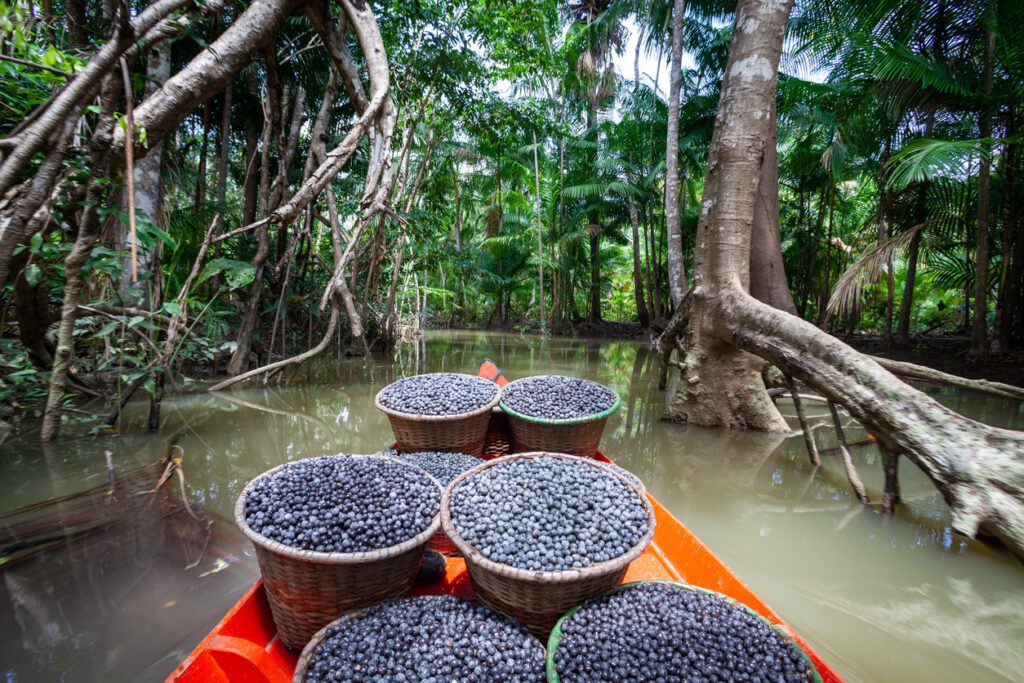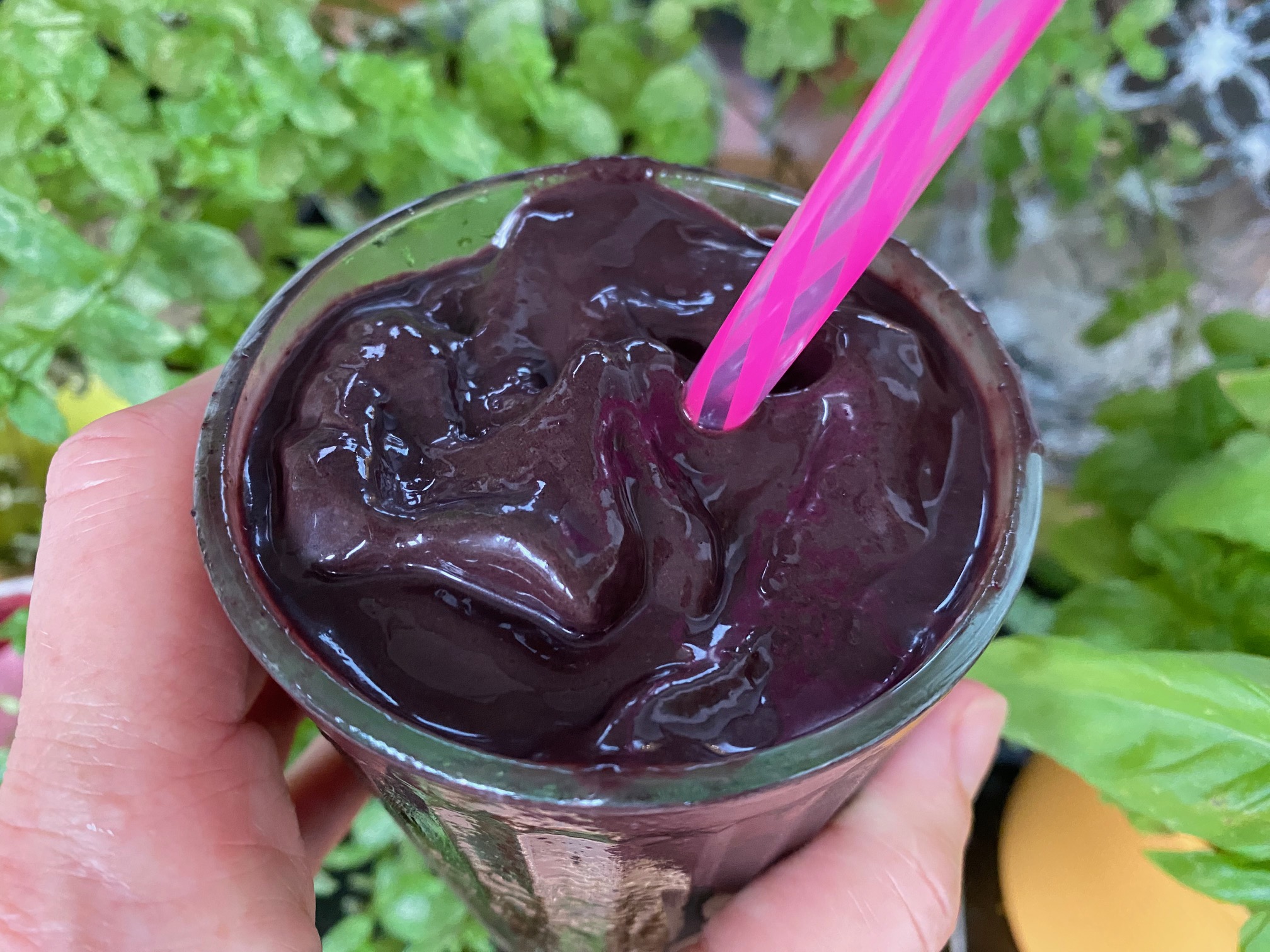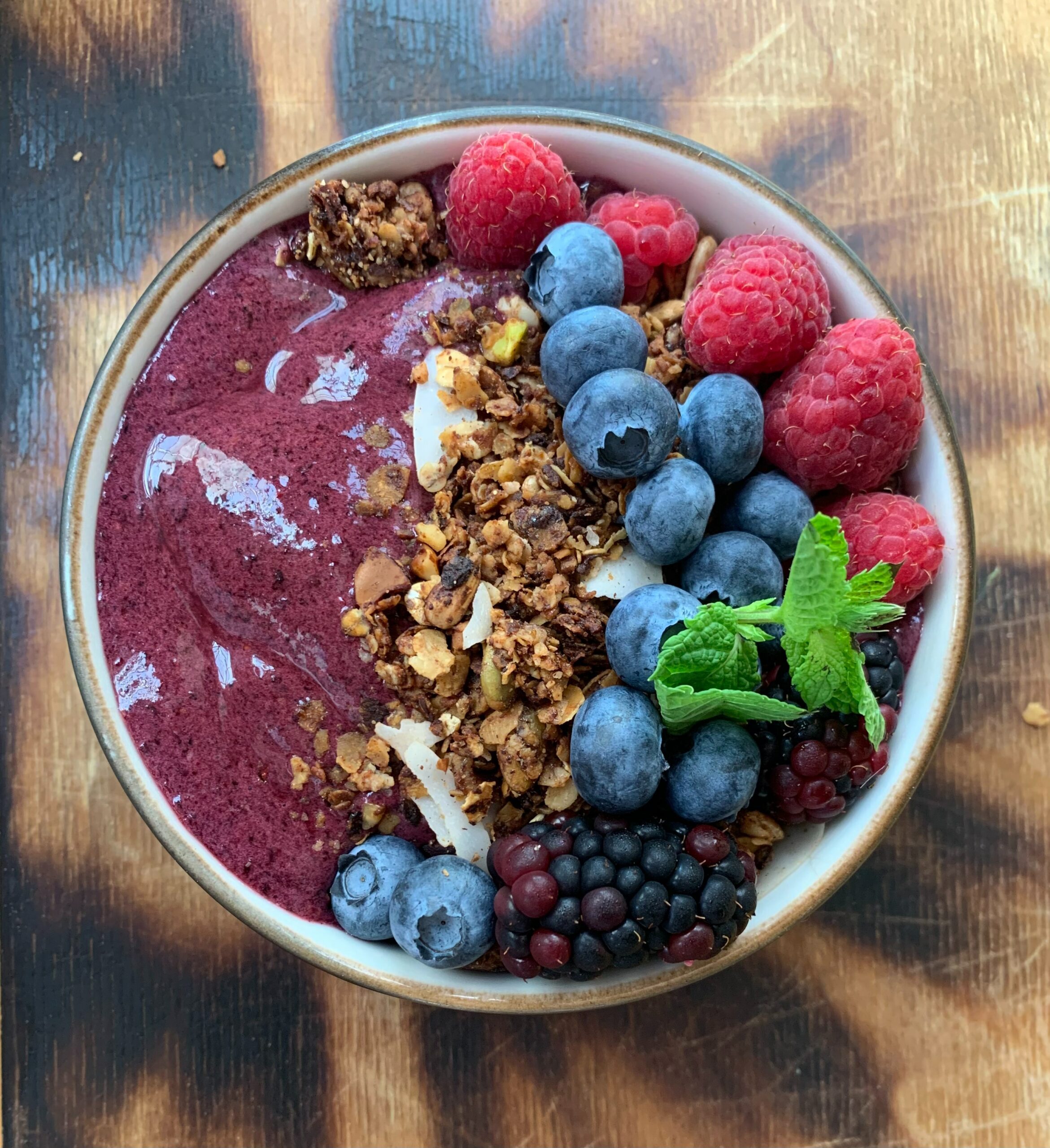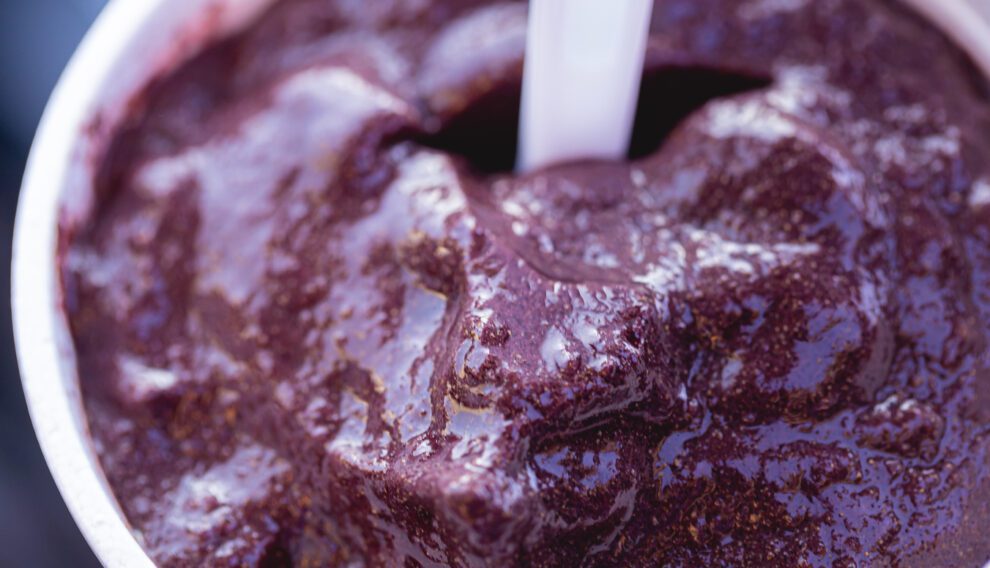Açai bowls have become popular as an everyday food for health-conscious people. They are known for extraordinary health benefits. However, there have been raised some concerns over high levels of manganese. Let’s explore how much açai is actually good for you…
Summary:
Eating a bowl of açaí (of around 100-200 ml fruit pulp) daily is not only safe, it is healthy. Eating açaí every day is common in Brazil, even in more significant amounts. Health benefits include heart, liver, kidney, brain, cardiovascular, and antioxidant and anti-inflammatory effects.
Açaí, the healthy berry from the Amazonian forest
Have you just discovered that your açaí bowl is a manganese bomb and wondered if you have overdosed on the trace mineral by eating a bowl every day? But you also remember having read that açai is beneficial for all kinds of stuff? If so, you are not alone in this confusion! Let’s see what is going on with the exotic berry and if it is healthy to eat it daily.
Açaí makes for a full nutritious meal!
Açaí berry, the fruit of the Amazonian palm tree Euterpe oleracea, is long-known in Brazil for its high nutrient density and is actively being researched for its health benefits. Açaí is often consumed to substitute for one “normal” meal and thus is an exciting source of nutrition in fruit-based diets.
Tropical fruits generally are more nutritious and richer in fats than temperate fruits and, thus, are an essential part of a successful raw diet, the human natural diet.
Açai is relatively high in fats, which partly consist of similar fatty acids as those found in avocados and olives. 100 grams of açaí pulp contains 5 grams of fat (this is around one-third of the fat in 100g avocado), of which over 60% are unsaturated. (Santos et al., 2018; Faria e Souza, 2017) Further, the berry is an excellent source of Omega-3s compared to other fatty fruits like avocados (high in omega-6) or coconut (no omega-3s).
Because of its flavor and health-promoting properties, açaí has gained enormous popularity as a health food in Europe and the US. The tropical berry is not just a newer trend food appreciated by the health community. It’s also a traditional food in the Amazonian Region of Brazil (see below)!
Health benefits of açaí
Açaí has many health benefits, such as cardiovascular benefits and reduction of oxidative stress. A recent review has concluded that “açaí possesses antioxidant and anti-inflammatory properties and exerts cardioprotective, gastroprotective, hepatoprotective, neuroprotective, renoprotective, antilipidemic, antidiabetic, and antineoplastic activities.” (Fornari Laurindo, 2023)
In simple words, açai is good for your:
- heart
- liver
- intestinal tract
- brain
- kidneys
- sugar metabolism
- lipid profile
- cellular health
Moreover, the researchers of this latest review see a huge potential for health promotion because they haven’t found any negative effects! Why the berry is such a superfood can certainly be explained by the human evolutionary past as frugivores. We are adapted to a diet high in tropical fruits. In fact, humans need the nutrition of tropical fruits for optimal health.
Açaí consumption in Brazil
Brazil has an impressive natural botanical wealth, including medicinal plants and tropical fruits. When you live in Brazil, you are basically in fruit heaven, as you can buy fruits, fruit juices, and smoothies at almost every corner indexed from A-Z!
One of Brazil’s famous fruits is the açaí berry, primarily sold in pulp and served as a semi-frozen smoothie or bowl with a unique, full flavor. It is one of the most popular fruits in Brazil: the “tigela de açaí” comes in many variations as mixtures with other fruits or toppings such as slices of bananas, mangoes, honey, nuts, and granola variations.
For example, in Amapa, 26 liters of açaí is consumed per person per year, which is around half a cup (0.7 dl) daily. Keep in mind that this is the average number, meaning that some people consume more than that, while others don’t eat açai at all. Daily consumption of one bowl of açaí is practiced in Brazil and even advised on local health sites.

How much açaí per day is recommended?
Adults and children over three years old can consume 180 ml of açaí daily, and children under the age of threes years old 100 ml, according to a Brazilian nutritionist. That means one acai bowl per day is recommended in the regions where the berry grows and is traditionally consumed.
However, in some Amazonian communities, the daily açaí intake reaches up to 2 liters a day. In conclusion, the high consumption of açaí does not lead to health issues or manganese toxicity in Brazil.
“For many years, it has been an important dietary source of nutrients for the Amazonian people, contributing up to 43% of their diet on a dry weight basis.”
Matta et al., 2020
Getting to know the people’s dietary habits in the country of the açaí berry already gives us a good indication of the safety of daily consumption. However, maybe local people are genetically adapted to the high manganese consumption and thus do not experience toxicity. Not likely in the evolutionary timeline, given that Brazil’s non-native population has not inhabited the area long enough to see adaptive traits.
Is the high manganese content in açaí a problem?
Açaí is one in a million when it comes to manganese: the berry is a league of its own with a whooping manganese content of up to 120 mg per 100 g pulp. This is extraordinary to the point that the NIH does not have any other food with similarly high manganese content listed in its factsheet.
Does the manganese content in açaí exceed recommendations?
Theoretically, yes, manganese in açai berry exceeds recommendations, but there is more to the story! So, how much of the mineral is actually recommended and how much is in the berries?
While the RDA (Recommended Dietary Allowance) is not established for manganese, the AI (Adequate Intake) is 2 mg/d, and the UL (Tolerable Upper Intake Level) is 11 mg:
| Manganese | |
| Recommended Dietary Allowance (RDA) | not established |
| Adequate Intake (AI) | ca. 2 mg / day |
| Tolerable Upper Intake Level (UL) | 11 mg / day |
| Manganese Source | Manganese (Mn) content (in mg) |
| 200 g açai (values from to cronometer.com) | 13 |
| 200 g açai (from da Silva Santos et al., 2014) | 9.5 |
| 200 g açai (from Oliveira et al. 2019) | between ca. 29 – 240 (total Mn content) |
| 200 g açai (from Oliveira et al. 2019) | ca. between 11 and 132 (bioavailable Mn content) |
One 200 ml açaí bowl contains around 13 mg of manganese (according to chronometer.com), which is at least six times the “adequate intake”. This is around 2 mg more than the “maximum” we should consume per day. However, there is a great variability in manganese content in the berries: this study (da Silva Santos et al., 2014) found 200 ml of açaí pulp to contain 9.5 mg of manganese, which is below the UL. While another study (Oliveira et al., 2019) states that 200 ml exceeds the AI by at least 50%.
Now, can we – based on those numer – conclude that 200 ml of açaí exceed the recommended manganese dosage? Let’s dive in a bit deeper:
Can manganese be overdosed from foods?
Mangenese is essential for health, but can cause toxicity in excess, which has been observed in miners and metal workers (occupational overexposure). But can we experience manganese toxicity from our diet? No, there is no known toxicity resulting from dietary manganese, only from inorganic manganese inhalation and water and precautions for over-supplementation.

No açaí toxicity found: Neither in real life nor in studies has there been shown manganese toxicity due to overconsumption of açaí. A toxicity evaluation of açaí in mice demonstrated no toxicity over 90 days (no acute toxicity and no “mutagenic, clastogenic, cytotoxic, or genotoxic” effects) in high doses up to 40g/kg bodyweight.
In plants, manganese is a cofactor for hundreds of enzymes and thus is loosely bound to the biochemical matrix of the plant cells. This is an important difference because the bioavailability (how much of a nutrient we actually absorb from food) of minerals and other compounds depends on their chemical form: The total concentration of an element in a plant alone does not define its toxicity!
For açaí, the bioavailability of manganese lies between 7 and 18% of the total amount. Generally, the larger part of manganese from food is quickly excreted, and only a small percentage is absorbed due to its poor solubility. Taking a manganese supplement, which comes in inorganic forms like manganese gluconate, manganese sulfate, manganese ascorbate, and amino acid chelates of manganese (see here), is therefore not the same as taking the compound within the plant food. Because overdosing on inorganic manganese is possible, consuming an adequate amount of açaí berry might be a natural alternative to supplements.
The manganese content in açaí is based on lab values and in-vitro studies. The concerns for manganese toxicity are hypothetical and are based on comparing the manganese levels found in the plant compared to toxicity data established with inhalation exposure. Consuming a mineral (or other compounds) within its natural, complex biochemical matrix can have very different effects than taking the isolated or inorganic form.
Summary: The reported adverse health effects of manganese only exist for inorganic manganese: dust inhalation in industrial workers (manganese dioxide) or drinking contaminated water (ionic manganese), but not for dietary intake. Dietary manganese toxicity has not been observed in humans.
Conclusion: How much açaí per day is safe and healthy?
Because of the absence of toxicity, it’s hard to determine a safe amount. Eating an açai bowl of around 200 ml per day is the usual recommendation in Brazil. Studies and real-life observations have shown no toxicity of açaí berries nor manganese toxicity from food sources in general Quite to the contrary, the berry has all kinds of health benefits. And to give the all-clear: eating açaí every day is common in Brazil and is considered safe and healthy, even in more significant amounts. Everything discussed so far points toward the answer: eating a bowl of açaí daily is safe. If you prefer to rule out any risk of overconsumption, you might want to eat an açai bowl 3-4 times a week instead of every day.

Manganese toxicity from açai is not a thing! Quite to the contrary: while manganese toxicity leads to neurological, Parkinson-like symptoms, the berry, on the other hand, is beneficial for neurological functions and has even been shown to help with Parkinson’s disease.
And let’s not lose sight of the bigger picture: the berry is a fruit, a natural food source for humans, which naturally are adapted to high fruit intake! Our body has sensory and instinctive intelligence! In animals (and humans), foods are commonly rejected and start to “taste not as good” if too much is consumed. In other cases, we react with digestive issues, like diarrhea, if something is consumed excessively. Those are all protection mechanisms that have kept us alive for eons and have warned and protected us from toxicity since before we had scales and sophisticated laboratories to measure the contents of minerals.
So, yes, I will continue to eat my delicious açaí pulp mixed with three bananas, 100 g of mangoes, grass juice powder, and a splash of distilled water almost every day, as long as I find it appealing and tasty.
Last updated on:
References
- Santos, H.O. (2018) “Effect of açaí (Euterpe oleracea) intake on vascular function and lipid profile: what is the recommendation?” International Journal of Cardiovascular Sciences [Preprint]. Available at: https://doi.org/10.5935/2359-4802.20180077.
- Faria e Souza, B.S. et al. (2017) “Effect of euterpe oleracea mart. (AÇAÍ) oil on dyslipidemia caused by cocos nuciferaL. saturated fat in wistar rats,” Journal of Medicinal Food, 20(9), pp. 830–837. Available at: https://doi.org/10.1089/jmf.2017.0027.
- N. Shiomi, V. Waisundara, Superfood and Functional Food: An Overview of Their Processing and Utilization. InTechOpen (2017)
- Laurindo, L.F. et al. (2023a) ‘Açaí (euterpe oleracea mart.) in health and disease: A critical review’, Nutrients, 15(4), p. 989. doi:10.3390/nu15040989.
- Ap É o estado que mais consome açaí no Brasil, Aponta IBGE; Média É de 26 Litros Por Pessoa no ano (no date) G1. Available at: https://g1.globo.com/ap/amapa/noticia/2020/04/07/ap-e-o-estado-que-mais-consome-acai-no-brasil-aponta-ibge-media-e-de-26-litros-por-pessoa-no-ano.ghtml (Accessed: March 31, 2023).
- Açaí Para Crianças: A partir de qual idade e qual quantidade por dia – verso (2019) Diário do Nordeste. Available at: https://diariodonordeste.verdesmares.com.br/verso/acai-para-criancas-a-partir-de-qual-idade-e-qual-quantidade-por-dia-1.2022826 (Accessed: March 31, 2023).
- (no date) Pesquisa Alerta sobre USO racional de planta na alimentaã§ã£o animal – aun USP. Available at: https://www.usp.br/aunantigo/exibir?id=5898&ed=1040&f=28 (Accessed: March 31, 2023).
- Matta, F.V. et al. (2020) “Chemical composition and bioactive properties of commercial and non-commercial purple and white açaí berries,” Foods, 9(10), p. 1481. Available at: https://doi.org/10.3390/foods9101481. )
- Oliveira, S.R. et al. (2019) “In vitro gastrointestinal digestion to evaluate the total, bioaccessible and bioavailable concentrations of iron and manganese in Açaí (euterpe oleracea mart.) pulps,” Journal of Trace Elements in Medicine and Biology, 53, pp. 27–33. Available at: https://doi.org/10.1016/j.jtemb.2019.01.016.
- Office of dietary supplements – manganese (no date) NIH Office of Dietary Supplements. U.S. Department of Health and Human Services. Available at: https://ods.od.nih.gov/factsheets/Manganese-HealthProfessional/#en38 (Accessed: March 31, 2023).
- DRI: Dietary reference intakes for vitamin A, vitamin K, arsenic, boron, chromium, copper, iodine, iron, manganese, molybdenum, nickel, silicon, vanadium, and zinc (2001). Washington, D.C.: National Academy Press.
- da Silva Santos, V., de Almeida Teixeira, G.H. and Barbosa, F. (2014) “Açaí (euterpe oleracea mart.): A tropical fruit with high levels of essential minerals—especially manganese—and its contribution as a source of natural mineral supplementation,” Journal of Toxicology and Environmental Health, Part A, 77(1-3), pp. 80–89. Available at: https://doi.org/10.1080/15287394.2014.866923.
- Li, L. and Yang, X. (2018) “The essential element manganese, oxidative stress, and metabolic diseases: Links and interactions,” Oxidative Medicine and Cellular Longevity, 2018, pp. 1–11. Available at: https://doi.org/10.1155/2018/7580707.
- Manganese (2023) Linus Pauling Institute. Available at: https://lpi.oregonstate.edu/mic/minerals/manganese (Accessed: March 31, 2023).
- Alejandro, S. et al. (2020) “Manganese in plants: From acquisition to subcellular allocation,” Frontiers in Plant Science, 11. Available at: https://doi.org/10.3389/fpls.2020.00300.
- Oliveira, S.R. et al. (2019) “In vitro gastrointestinal digestion to evaluate the total, bioaccessible and bioavailable concentrations of iron and manganese in Açaí (euterpe oleracea mart.) pulps,” Journal of Trace Elements in Medicine and Biology, 53, pp. 27–33. Available at: https://doi.org/10.1016/j.jtemb.2019.01.016.
- Rondanelli, M. et al. (2021) “Essentiality of manganese for Bone Health: An overview and update,” Natural Product Communications, 16(5). Available at: https://doi.org/10.1177/1934578×211016649.
- Schauss, A.G. et al. (2010) “Safety Evaluation of an açai-fortified fruit and Berry Functional Juice Beverage (Monavie Active®),” Toxicology, 278(1), pp. 46–54. Available at: https://doi.org/10.1016/j.tox.2010.04.017.
- de Moura, R.S. and Resende, Â.C. (2016) “Cardiovascular and metabolic effects of Açaí, an Amazon Plant,” Journal of Cardiovascular Pharmacology, 68(1), pp. 19–26. Available at: https://doi.org/10.1097/fjc.0000000000000347.
- Sun, X. et al. (2010) “Açai palm fruit (Euterpe Oleracea Mart.) pulp improves survival of flies on a high fat diet,” Experimental Gerontology, 45(3), pp. 243–251. Available at: https://doi.org/10.1016/j.exger.2010.01.008.
- ALNasser, M.N. and Mellor, I.R. (2022) “Neuroprotective activities of acai berries (Euterpe sp.): A Review,” Journal of Herbmed Pharmacology, 11(2), pp. 166–181. Available at: https://doi.org/10.34172/jhp.2022.21.
- D’Amico, R. et al. (2022) “Açai Berry mitigates Parkinson’s disease progression showing dopaminergic neuroprotection via NRF2-Ho1 Pathways,” Molecular Neurobiology, 59(10), pp. 6519–6533. Available at: https://doi.org/10.1007/s12035-022-02982-5.


Add Comment